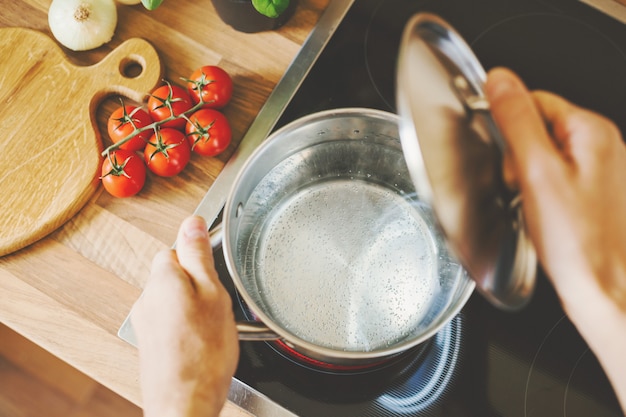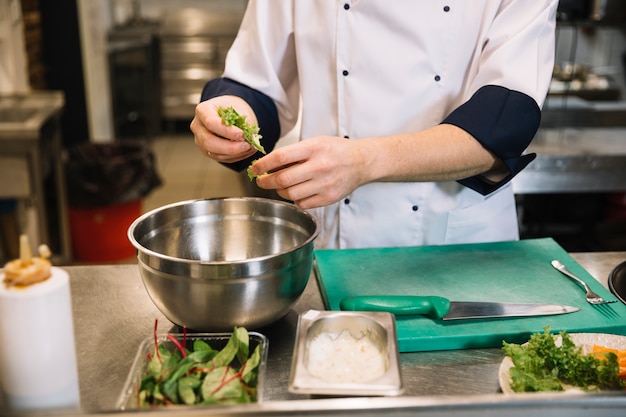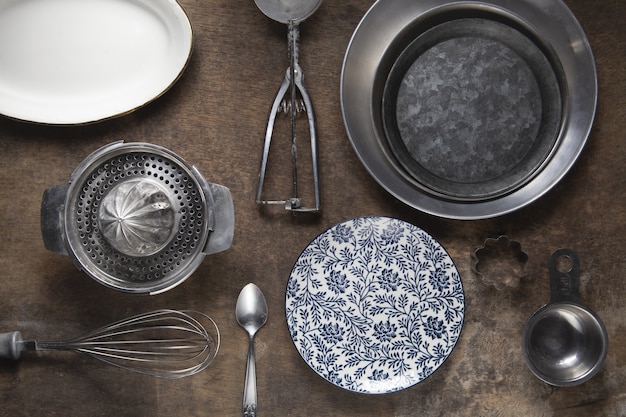As a seasoned cook, my kitchen is my sanctuary, a place where creativity meets culinary passion. And at the heart of my cooking adventures lies a collection of trusty stainless steel cookware. I remember when I first started out, I was intimidated by its sleek, gleaming surface. "Stainless steel? Isn't that just for Michelin-star chefs?" I wondered. But over time, I realized that stainless steel is anything but intimidating. In fact, it's incredibly versatile, durable, and capable of producing truly exceptional results.
If you're ready to unlock the potential of your stainless steel cookware and elevate your cooking to new heights, this guide is your compass. We'll embark on a journey together, exploring everything from choosing the right pots and pans to mastering essential techniques that will transform your cooking experience. We'll delve into the science behind stainless steel, unraveling common misconceptions and tackling those pesky burning and sticking issues head-on. And trust me, I'll be sharing my personal tips and tricks – the ones I've learned from years of trial and error – along the way. Let's get cooking!
(Part 1) Why Stainless Steel? The Unrivaled Champion of the Kitchen

Before we jump into the technical details, let's talk about why stainless steel is such a beloved choice for cookware, a favorite among both home cooks and professional chefs. It's not just about its good looks, though the gleam of a well-maintained stainless steel pot is undeniably alluring.
Beyond Durability: The Benefits of Stainless Steel
Imagine having a set of cookware that you can pass down to your children, a testament to its enduring quality. That's the magic of stainless steel. It's a long-lasting investment, a kitchen companion that will be by your side for years to come. But its appeal goes far beyond its resilience:
- Even Heating: One of the key reasons why stainless steel is a chef's favorite is its exceptional heat distribution. Unlike some other materials, stainless steel heats up evenly, ensuring that your food cooks consistently, from the center to the edges. This is crucial for searing steaks, making delicate sauces, and achieving perfectly cooked vegetables. Uneven heating can lead to burnt edges and undercooked centers, something we all want to avoid.
- Non-Reactive: Stainless steel is incredibly stable and doesn't react with acidic foods. You can cook anything you like, from tomato-based sauces to citrusy marinades, without worrying about altering the flavor. This is a huge advantage, especially when you're working with delicate ingredients where even a slight metallic taste can ruin the dish.
- Easy to Clean: One of my favorite aspects of stainless steel is how effortlessly it cleans. A quick scrub with soap and water is usually all it takes to get your pots and pans sparkling clean. No need for complicated cleaning routines, soaking for hours, or using harsh chemicals.
- Versatile: From stovetop to oven, stainless steel can handle it all. It's a truly versatile material, making it an indispensable tool in any kitchen. You can sauté, sear, simmer, bake, and even braise in your stainless steel cookware. The possibilities are endless!
(Part 2) Choosing Your Stainless Steel Cookware: A Guide to Finding the Perfect Fit

Now that you're convinced of stainless steel's merits, it's time to select the perfect pieces for your kitchen. Don't simply grab the first set you see – choosing wisely will ensure you have the right tools to unleash your culinary creativity.
Key Considerations When Choosing Stainless Steel Cookware
- Material Quality: Not all stainless steel is created equal. Look for cookware made from high-quality stainless steel, usually denoted by a number like 18/10 or 18/8. These numbers refer to the percentage of chromium and nickel in the alloy, which affect its durability and resistance to rust and corrosion. Higher numbers indicate a higher quality material. For example, 18/10 stainless steel is known for its exceptional durability, resistance to corrosion, and ability to withstand high temperatures.
- Construction: Opt for pieces with a tri-ply or multi-ply construction. These are the real stars of the stainless steel world. Tri-ply cookware has three layers: stainless steel on the outside and inside, with a core of aluminum or copper sandwiched in between. Multi-ply construction takes this concept further, incorporating additional layers for even better heat distribution. These layered constructions ensure even heating throughout the cookware, preventing hot spots and ensuring consistent cooking results.
- Handle Design: Choose pots and pans with handles that are sturdy, comfortable to grip, and heat-resistant. You don't want to accidentally burn yourself while stirring your delicious creations! Look for handles that are riveted or welded to the cookware for added durability and strength.
- Size and Shape: Consider your cooking needs and choose a variety of sizes and shapes to suit your recipes. A good starting set often includes:
- A saucepan for making sauces, soups, and pasta.
- A stockpot for boiling large quantities of water or preparing soups and stews.
- A sauté pan for sauteing vegetables, making stir-fries, and preparing sauces.
- A frying pan for searing meats, frying eggs, and making pancakes.
- A dutch oven for braising, roasting, and slow cooking.
- Price Point: Stainless steel cookware can range in price from budget-friendly to high-end. Choose a set that fits your budget and offers the quality and features you need. Remember, investing in quality stainless steel cookware is an investment in your cooking, a decision that will reward you for years to come.
(Part 3) The Science Behind Stainless Steel: Understanding Heat Distribution

You might think that all stainless steel cookware is created equal, but the truth is, different materials and construction techniques can have a profound impact on how your food cooks. Think of your stainless steel cookware as a conductor of heat, and it's important to understand how that heat is transferred to ensure that your food cooks evenly and beautifully.
What is the Science Behind Heat Distribution in Stainless Steel Cookware?
When you place a stainless steel pot on your stovetop, heat is transferred through a combination of three processes:
- Conduction: Heat is transferred through the cookware's material. The more dense and conductive the metal, the faster the heat travels. Stainless steel is a good conductor of heat, but certain alloys, like those with a higher nickel content, are even better conductors.
- Convection: Heat is transferred through the movement of air or liquids. As the heat from the stovetop reaches your cookware, it warms the air inside the pot, creating convection currents. This movement of air helps to distribute the heat more evenly.
- Radiation: Heat is transferred through electromagnetic waves. This is how the heat from your stovetop reaches your cookware.
The Importance of Tri-Ply or Multi-Ply Construction
This is where tri-ply or multi-ply construction shines. By sandwiching layers of aluminum or copper between layers of stainless steel, you create a more efficient heat conductor. The aluminum or copper core, with its excellent heat conductivity, helps to transfer heat evenly throughout the cookware, while the stainless steel layers provide durability and a smooth cooking surface. Think of it as a team effort – the aluminum or copper core does the heavy lifting of transferring heat, while the stainless steel layers provide the strength and stability. This construction leads to more even heating, preventing hot spots and ensuring that your food cooks consistently, whether you're searing a steak or simmering a delicate sauce.
(Part 4) Mastering Essential Techniques: The Art of Stainless Steel Cooking
Alright, you've chosen your perfect stainless steel cookware and understand the science behind its heat distribution. Now, let's talk techniques, the secrets to unlocking the full potential of your stainless steel pots and pans.
Heating and Seasoning Your Stainless Steel Cookware
Before you start cooking, take a moment to properly heat and season your stainless steel pots and pans. This simple step will help prevent sticking and ensure even cooking, a foundation for culinary success.
- Heat Slowly: Avoid putting a cold stainless steel pan on high heat. It can cause warping or create uneven hot spots, ruining your dish. Start on medium heat and gradually increase as needed. Patience is key!
- Season with Oil or Fat: Before adding your food, always heat a thin layer of oil or fat in your pan. This is a crucial step in preventing sticking. The oil or fat creates a barrier between your food and the stainless steel, allowing your food to cook evenly and release easily from the pan.
- Use the Right Oil: Not all oils are created equal. Choose an oil with a high smoke point, like avocado oil, grapeseed oil, or peanut oil, which can withstand higher temperatures without burning. These oils will provide a stable cooking surface and prevent your oil from smoking or burning, preserving the flavor of your dish.
- Avoid Overcrowding: Don't overcrowd your pan. Give your food space to cook evenly and avoid steaming. If you try to cook too much food at once, it will create a steaming effect, preventing proper browning and making your food soggy.
Common Mistakes and How to Avoid Them
We all make mistakes in the kitchen, and stainless steel is no exception. But don't worry, by understanding common pitfalls, you can avoid them and become a stainless steel cooking master.
- Over-Heating: If you hear your stainless steel pan making a high-pitched humming sound, it's a sign that it's getting too hot. Reduce the heat immediately to prevent warping or burning your food.
- Under-Seasoning: Don't skip the oil or fat! A well-seasoned pan is key to preventing sticking and achieving beautiful results.
- Over-Stirring: Let your food cook undisturbed for a few minutes before stirring to develop a nice sear. Constantly moving your food around will prevent it from browning properly and developing those beautiful crusty edges. Patience is key to success!
- Cleaning with Abrasive Materials: Avoid using steel wool or abrasive scrubbers on your stainless steel cookware. They can scratch the surface, creating an uneven cooking surface and making your cookware less effective. Stick to non-abrasive sponges or soft cloths for cleaning.
(Part 5) Recipes That Shine in Stainless Steel: Culinary Masterpieces
There's a reason why stainless steel is a kitchen staple – it excels in so many cooking scenarios, making it a versatile tool for a wide range of culinary creations.
Searing and Browning: The Art of Perfect Crust
stainless steel pans are the undisputed champions of searing and browning. Their even heat distribution allows you to control the browning process, achieving a beautiful, crispy crust on meats, poultry, and vegetables. Think of those perfectly seared steaks, with their rich, flavorful crust, or those golden-brown roasted vegetables, bursting with flavor. Stainless steel makes it all possible.
Making Sauces: From Simple to Sophisticated
Stainless steel saucepans are ideal for reducing sauces and creating velvety smooth textures. The non-reactive nature of stainless steel ensures that your sauce doesn't pick up any metallic flavors, preserving the purity of the ingredients and allowing the flavors to shine through.
Boiling and Steaming: The Foundations of Flavor
Stainless steel stockpots are perfect for boiling water, making soups, and steaming vegetables. They're durable, hold plenty of liquid, and distribute heat evenly, ensuring that your food cooks consistently and thoroughly. Whether you're making a classic chicken broth or a fragrant vegetable broth, your stainless steel stockpot will be your reliable companion.
(Part 6) FAQs: Unveiling the Secrets of Stainless Steel
Now that you're armed with knowledge and ready to conquer your stainless steel cookware, let's address some common questions.
- Q: What if my food keeps sticking to the pan?
A: Make sure you're heating your pan properly and using a thin layer of oil or fat. If sticking persists, consider using a nonstick spatula or a silicone cooking spoon. And remember, the more you use your stainless steel cookware, the better seasoned it will become. Over time, the surface will develop a natural patina, making it less prone to sticking.
- Q: How do I clean burnt food off my stainless steel cookware?
A: First, try soaking the cookware in hot soapy water. If the burnt residue is stubborn, create a paste of baking soda and water, apply it to the burnt areas, and let it sit for a few minutes. Then, scrub gently with a non-abrasive sponge. You can also use a specialized stainless steel cleaner, which is designed to remove tough stains and maintain the shine of your cookware.
- Q: Can I put stainless steel cookware in the dishwasher?
A: While most stainless steel cookware is dishwasher-safe, hand washing is always recommended to prolong its lifespan. Dishwasher detergents can be harsh and can dull the finish over time. Hand washing also allows you to inspect your cookware more closely for any signs of damage or wear and tear.
- Q: How do I prevent my stainless steel cookware from getting scratched?
A: Avoid using abrasive scrubbers, metal utensils, or sharp knives on your stainless steel cookware. These can scratch the surface, making it less effective and potentially affecting the longevity of your cookware. Use wooden or silicone utensils instead.
- Q: How do I know if my stainless steel cookware is the right quality?
A: Look for cookware made from high-quality stainless steel, usually denoted by a number like 18/10 or 18/8. This indicates the percentage of chromium and nickel in the alloy, which affect its durability and resistance to rust and corrosion. Higher numbers indicate a higher quality material. You should also feel the weight of the cookware – high-quality stainless steel cookware is usually heavier and more substantial.
(Part 7) My Top 5 Stainless Steel Cookware Tips
Here's a quick summary of my hard-earned, kitchen-tested tips, distilled from years of experience and culinary adventures:
- Heat it slowly: Avoid shock by starting on medium heat and gradually increasing as needed.
- Season with oil or fat: Always use a thin layer of oil or fat to create a nonstick surface.
- Avoid overcrowding: Give your food space to cook evenly and prevent steaming.
- Handle with care: Don't use abrasive scrubbers or metal utensils.
- Invest in quality: Choose cookware made from high-quality stainless steel with a tri-ply or multi-ply construction.
(Part 8) Embracing the Journey: A Love Affair with Stainless Steel
My love affair with stainless steel cookware started years ago, and it continues to grow stronger with each delicious dish I create. It's more than just a set of pots and pans – it's a symbol of my culinary journey, filled with experimentation, discovery, and an unwavering passion for good food.
This guide has been my way of sharing that passion with you. Now, it's your turn to embark on your own culinary adventure with stainless steel. Embrace the process, learn from your experiences, and remember, the journey is just as rewarding as the destination. Happy cooking!
Everyone is watching

Perfect Rice Every Time: The Ultimate Guide to Cooking Rice
Cooking TipsAs a self-proclaimed foodie, I've always been a bit obsessed with rice. It's the foundation of countless cuisi...

Prime Rib Roast Cooking Time Chart: Per Pound Guide
Cooking TipsPrime rib roast. Just the name conjures images of lavish dinners, crackling fires, and hearty laughter. It’s ...

The Ultimate Guide to Cooking Asparagus: Tips, Techniques, and Recipes
Cooking TipsAsparagus. The mere mention of this spring delicacy conjures up images of vibrant green spears, crisp and burs...

Ultimate Guide to Cooking the Perfect Thanksgiving Turkey
Cooking TipsThanksgiving. Just the word conjures up images of overflowing tables laden with delicious food, the scent of r...

How Long to Bake Potatoes in the Oven (Perfect Every Time)
Cooking TipsBaked potatoes are a staple in my kitchen. They're incredibly versatile, delicious, and surprisingly easy to m...
